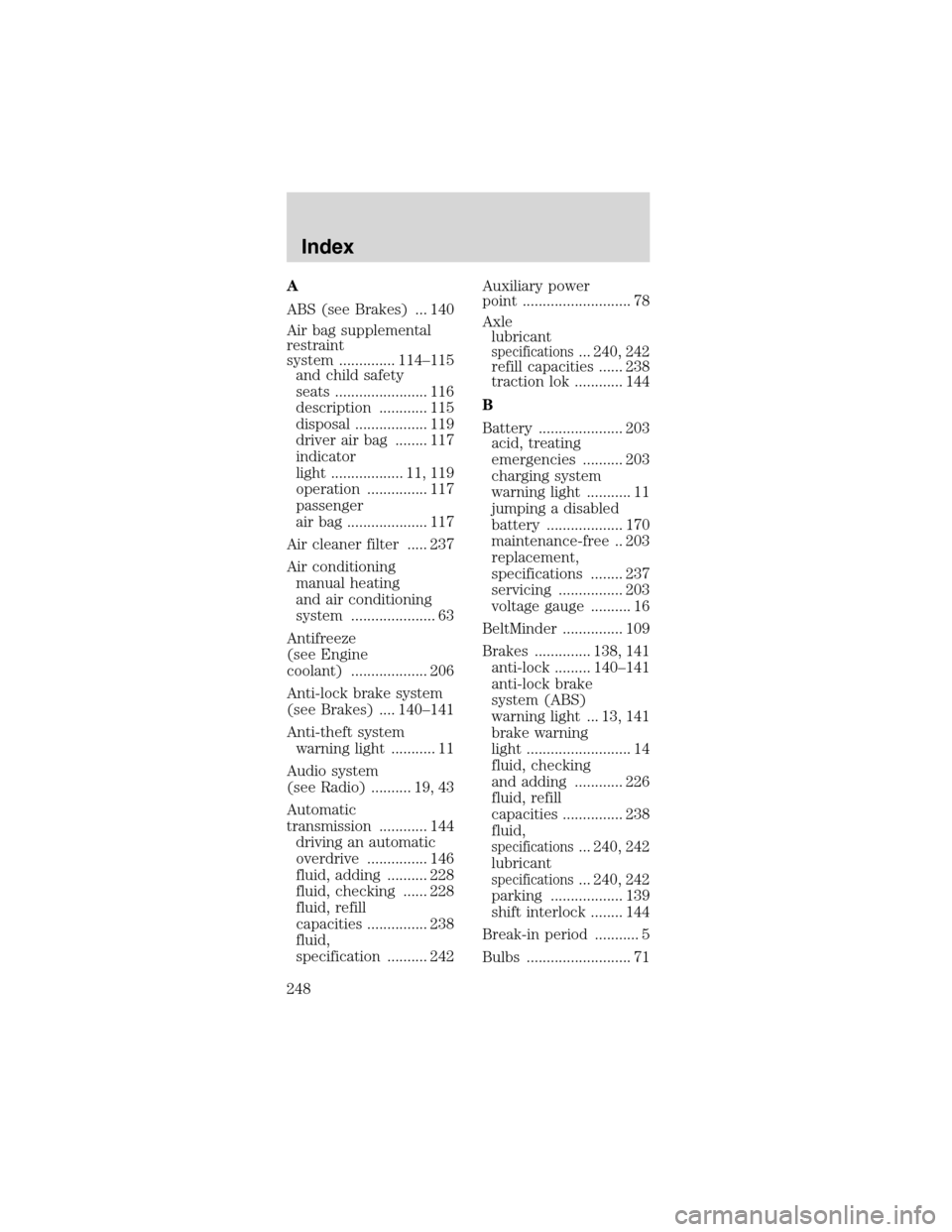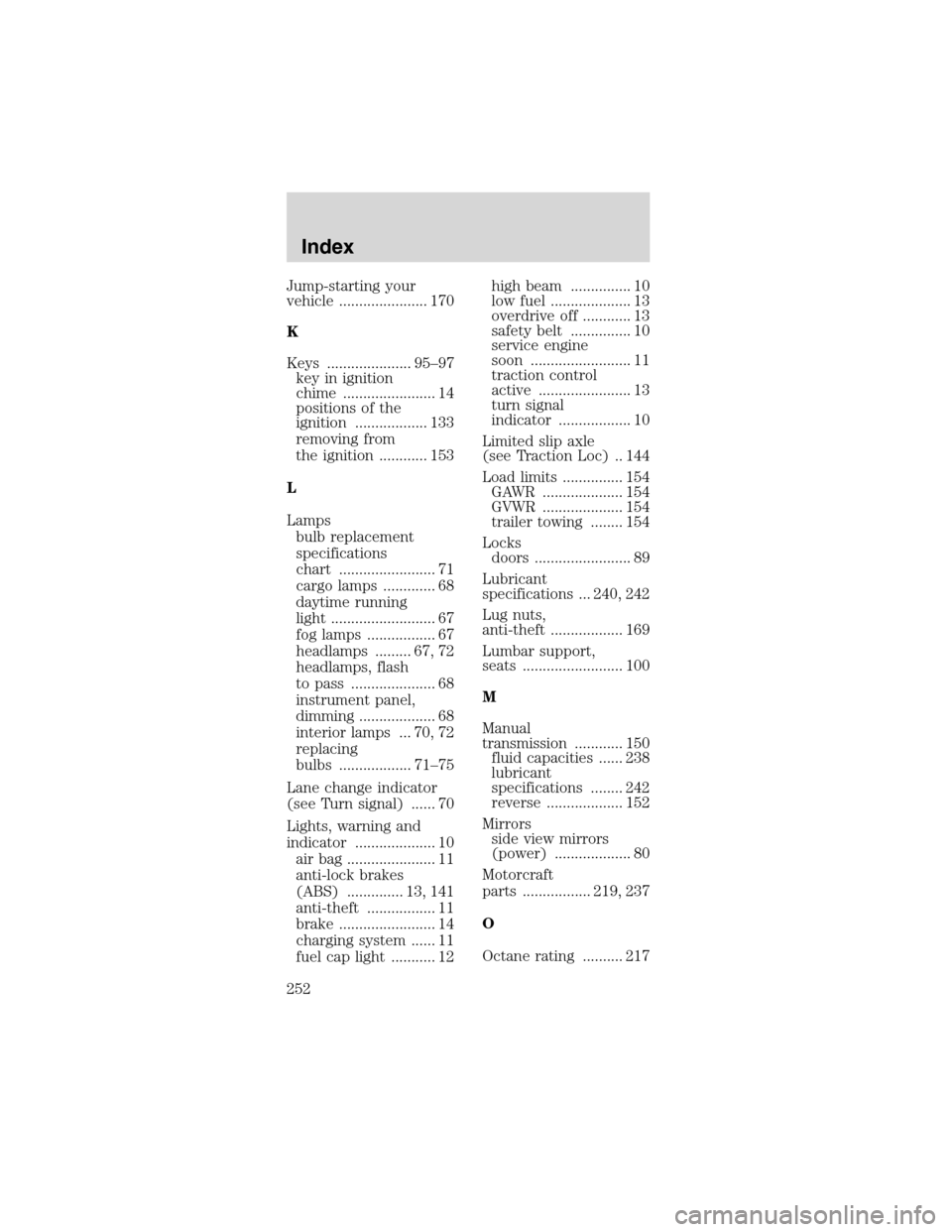2003 FORD MUSTANG brake light
[x] Cancel search: brake lightPage 199 of 256

WINDSHIELD WASHER FLUID
Check the washer fluid
whenever you stop for
fuel. The reservoir is
highlighted with a
symbol.
Add fluid to fill the
reservoir if the level is
low. In very cold
weather, do not fill the
reservoir completely.
Only use a washer fluid that meets Ford
specification ESR-M17P5–A . Refer toLubricant
specificationsin this chapter.
State or local regulations on volatile organic
compounds may restrict the use of methanol, a
common windshield washer antifreeze additive.
Washer fluids containing non-methanol antifreeze
agents should be used only if they provide cold
weather protection without damaging the vehicle’s
paint finish, wiper blades or washer system.
Note:Do not put washer fluid in the engine coolant
reservoir. Washer fluid placed in the cooling system
may harm engine and cooling system components.
ENGINE OIL
Checking the engine oil
Refer to the scheduled maintenance guide for the
appropriate intervals for checking the engine oil.
1. Make sure the vehicle is on level ground.
2. Turn the engine off and wait 5 to 10 minutes for
the oil to drain into the oil pan.
3. Set the parking brake and ensure the gearshift is
securely latched in P (Park) (automatic
transmissions) or 1 (First) (manual transmissions).
4. Open the hood. Protect yourself from engine heat.
Maintenance and Specifications
199
Page 204 of 256

Batteries normally produce explosive gases
which can cause personal injury. Therefore,
do not allow flames, sparks or lighted substances
to come near the battery. When working near the
battery, always shield your face and protect your
eyes. Always provide proper ventilation.
When lifting a plastic-cased battery,
excessive pressure on the end walls could
cause acid to flow through the vent caps, resulting
in personal injury and/or damage to the vehicle or
battery. Lift the battery with a battery carrier or
with your hands on opposite corners.
Keep batteries out of reach of children.
Batteries contain sulfuric acid. Avoid contact
with skin, eyes or clothing. Shield your eyes when
working near the battery to protect against
possible splashing of acid solution. In case of acid
contact with skin or eyes, flush immediately with
water for a minimum of 15 minutes and get
prompt medical attention. If acid is swallowed, call
a physician immediately.
Battery posts, terminals and related
accessories contain lead and lead
compounds.Wash hands after handling.
Because your vehicle’s engine is electronically
controlled by a computer, some control conditions
are maintained by power from the battery. When the
battery is disconnected or a new battery is installed,
the engine must relearn its idle and fuel trim
strategy for optimum driveability and performance.
To begin this process:
1. With the vehicle at a complete stop, set the
parking brake.
2. Put the gearshift in P (Park) (automatic
transmission) or the neutral position (manual
transmission), turn off all accessories and start the
engine.
Maintenance and Specifications
204
Page 222 of 256

•Using the air conditioner or defroster may reduce
fuel economy.
•You may want to turn off the speed control in
hilly terrain if unnecessary shifting between third
and fourth gear occurs. Unnecessary shifting of
this type could result in reduced fuel economy.
•Warming up a vehicle on cold mornings is not
required and may reduce fuel economy.
•Resting your foot on the brake pedal while driving
may reduce fuel economy.
•Combine errands and minimize stop-and-go
driving.
Maintenance
•Keep tires properly inflated and use only
recommended size.
•Operating a vehicle with the wheels out of
alignment will reduce fuel economy.
•Use recommended engine oil. Refer toLubricant
specificationsin this chapter.
•Perform all regularly scheduled maintenance
items. Follow the recommended maintenance
schedule and owner maintenance checks found in
your vehicle scheduled maintenance guide.
Conditions
•Heavily loading a vehicle or towing a trailer may
reduce fuel economy at any speed.
•Carrying unnecessary weight may reduce fuel
economy (approximately 0.4 km/L [1 mpg] is lost
for every 180 kg [400 lb] of weight carried).
•Adding certain accessories to your vehicle (for
example bug deflectors, rollbars/light bars,
running boards, ski/luggage racks) may reduce
fuel economy.
•Using fuel blended with alcohol may lower fuel
economy.
•Fuel economy may decrease with lower
temperatures during the first 12–16 km (8–10
miles) of driving.
Maintenance and Specifications
222
Page 248 of 256

A
ABS (see Brakes) ... 140
Air bag supplemental
restraint
system .............. 114–115
and child safety
seats ....................... 116
description ............ 115
disposal .................. 119
driver air bag ........ 117
indicator
light .................. 11, 119
operation ............... 117
passenger
air bag .................... 117
Air cleaner filter ..... 237
Air conditioning
manual heating
and air conditioning
system ..................... 63
Antifreeze
(see Engine
coolant) ................... 206
Anti-lock brake system
(see Brakes) .... 140–141
Anti-theft system
warning light ........... 11
Audio system
(see Radio) .......... 19, 43
Automatic
transmission ............ 144
driving an automatic
overdrive ............... 146
fluid, adding .......... 228
fluid, checking ...... 228
fluid, refill
capacities ............... 238
fluid,
specification .......... 242Auxiliary power
point ........................... 78
Axle
lubricant
specifications... 240, 242
refill capacities ...... 238
traction lok ............ 144
B
Battery ..................... 203
acid, treating
emergencies .......... 203
charging system
warning light ........... 11
jumping a disabled
battery ................... 170
maintenance-free .. 203
replacement,
specifications ........ 237
servicing ................ 203
voltage gauge .......... 16
BeltMinder ............... 109
Brakes .............. 138, 141
anti-lock ......... 140–141
anti-lock brake
system (ABS)
warning light ... 13, 141
brake warning
light .......................... 14
fluid, checking
and adding ............ 226
fluid, refill
capacities ............... 238
fluid,
specifications... 240, 242
lubricant
specifications... 240, 242
parking .................. 139
shift interlock ........ 144
Break-in period ........... 5
Bulbs .......................... 71
Index
248
Page 252 of 256

Jump-starting your
vehicle ...................... 170
K
Keys ..................... 95–97
key in ignition
chime ....................... 14
positions of the
ignition .................. 133
removing from
the ignition ............ 153
L
Lamps
bulb replacement
specifications
chart ........................ 71
cargo lamps ............. 68
daytime running
light .......................... 67
fog lamps ................. 67
headlamps ......... 67, 72
headlamps, flash
to pass ..................... 68
instrument panel,
dimming ................... 68
interior lamps ... 70, 72
replacing
bulbs .................. 71–75
Lane change indicator
(see Turn signal) ...... 70
Lights, warning and
indicator .................... 10
air bag ...................... 11
anti-lock brakes
(ABS) .............. 13, 141
anti-theft ................. 11
brake ........................ 14
charging system ...... 11
fuel cap light ........... 12high beam ............... 10
low fuel .................... 13
overdrive off ............ 13
safety belt ............... 10
service engine
soon ......................... 11
traction control
active ....................... 13
turn signal
indicator .................. 10
Limited slip axle
(see Traction Loc) .. 144
Load limits ............... 154
GAWR .................... 154
GVWR .................... 154
trailer towing ........ 154
Locks
doors ........................ 89
Lubricant
specifications ... 240, 242
Lug nuts,
anti-theft .................. 169
Lumbar support,
seats ......................... 100
M
Manual
transmission ............ 150
fluid capacities ...... 238
lubricant
specifications ........ 242
reverse ................... 152
Mirrors
side view mirrors
(power) ................... 80
Motorcraft
parts ................. 219, 237
O
Octane rating .......... 217
Index
252
Page 253 of 256

Odometer ................... 17
Oil (see
Engine oil) ............... 199
Overdrive ........... 84, 146
P
Panic alarm feature,
remote entry
system ........................ 92
Parking brake .......... 139
Parts (see Motorcraft
parts) ....................... 237
Power distribution
box (see Fuses) ...... 163
Power door locks ...... 89
Power mirrors ........... 80
Power point ............... 78
Power steering ........ 142
fluid, checking
and adding ............ 225
fluid, refill
capacity ................. 238
fluid,
specifications... 240, 242
Power Windows ......... 78
R
Radio .................... 19, 43
Radio reception ... 61–62
Rear window
defroster .................... 66
Relays ...................... 160
Remote entry
system .................. 91–92
illuminated entry .... 94locking/unlocking
doors .................. 89, 92
opening the trunk ... 93
panic alarm ............. 92
replacement/additional
transmitters ............. 94
replacing the
batteries .................. 93
Roadside
assistance ................ 157
S
Safety belts (see
Safety restraints) ..... 14,
102, 104–107
Safety defects,
reporting .................. 186
Safety
restraints... 102, 104–107
belt minder ........... 109
cleaning the
safety belts ............ 113
extension
assembly ................ 113
for adults ....... 104–107
for children ... 119–120
warning light
and chime ............... 10,
14, 108–109
Safety seats
for children .............. 123
Seat belts (see Safety
restraints) ................ 102
Seats .......................... 99
child safety seats .. 123
SecuriLock passive
anti-theft
system .................. 95–97
Index
253